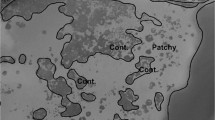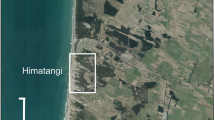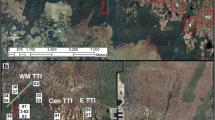Abstract
Mosquito control measures have resulted in majorstructural alterations of many coastal marshes, withrelatively unknown consequences to larger ecosystemfunctioning. Parallel grid ditching and open marshwater management (OMWM) techniques are purposefullydesigned to alter the hydrological regime and therelative availability and/or characteristics ofstanding water on the marsh surface. With the growingrecognition of the important influence that habitatstructure and the configuration of the marsh-edgeboundary has on nekton utilization of salt marshsystems, the impact of mosquito control managementtechniques on the availability and quality of saltmarsh habitat deserves increased scrutiny. Usingdigital image processing techniques, we completed adetailed mapping effort for a 1800 ha study area inTuckerton, New Jersey to provide a picture ofsubtidal and intertidal habitat availability. Spatialanalysis techniques were used to quantify the relativeamount of habitat types and spatial pattern of theland-water interface under different managementregimes: parallel grid-ditched, OMWM and an unalteredreference. The parallel grid-ditched site had a muchlower incidence of marsh ponds which serve asimportant low tide and over-wintering refuge forcertain species of fish. In comparison, the OMWM sitehad a much greater amount of ponded water habitats.The grid-ditched site had a higher density of marshsurface-to-tidal water interface resulting in a lowermedian distance between the marsh interior and theadjacent tidal channel network. This study serves tobenchmark the habitat structure and spatial pattern ofa highly functioning natural marsh for use as areference site in regional wetland creation orrestoration efforts.
Similar content being viewed by others
References
Able, K.W. Witting, D.A., McBride, R.S., Rountree, R.A. and Smith, K.J. 1996. Fishes of polyhaline estuarine shores in Great Bay-Little Egg Harbor, New Jersey: a case study of seasonal and habitat influences. In: Nordstrom, K.F. and Roman C.T. (eds.), Estuarine Shores: Evolution, Environments and Human Alteration. pp. 335–353. John Wiley & Sons, New York, New York.
Abrahams, A.D. 1984. Channel networks: a geomorphological perspective. Water Resources Research. 20: 161–168.
Aronson, J. and Dhillion, S. and Le Floc'H, E. 1995 On the need to select an ecosystem of reference, however imperfect: a reply to Pickett and Parker. Restoration Ecology 3: 1–3.
Boesch, D.F. and Turner, R.E. 1984. Dependence of fishery species on salt marshes: the role of food and refuge. Estuaries 7: 460–468.
Bourn, W.S. and Cottam, C. 1950. Some Biological effects of ditching tidewater marshes. U.S. Fish and Wildlife Service Research Report 19. 30 pp. Washington, D.C.
Brinson, M.M. and Rheinhardt, R. 1996. The role of reference wetlands in functional assessment and mitigation. Ecological Applications 6: 69–76.
Browder, J.A., May, L.N., Rosenthal, A., Gosselink, J.G. and Baumann, R.H. 1989. Modeling future trends in wetland loss and brown shrimp production in Louisiana using Thematic Mapper imagery. Remote Sensing of Environment 28: 45–59.
Burger, J., Shisler, J.K. and Lesser, F.H. 1982. Avian utilization on six salt marshes in New Jersey. Biological Conservation 23: 187–212.
Candeletti, T. 1998. Ocean County Mosquito Commission, Barnegat, New Jersey. Personal communication.
Chapman, V.J. 1960. Salt marshes and salt deserts of the world. Interscience Publishers, London.
Daiber, F.C. 1974. Salt marsh plants and future salt coastal marshes in relation to animals. In: Reimold, R.J. and Queen, W.H. (eds.), Ecology of halophytes. pp. 475–508. Academic Press, New York.
Daiber, F.C. 1987. A brief history of tidal marsh mosquito control. In: Waterfowl and Wetlands: Proceedings of a Symposium on Waterfowl and Wetlands Management in the Coastal Zone of the Atlantic Flyway. pp. 234–252. Delaware Department of Natural. Resources and Environmental Control, Dover, Delaware.
Durand, J.R. 1988. Field studies in the Mullica River-Great Bay estuarine system. Volume 1. Rutgers University, Center for Coastal and Environmental studies, New Brunswick, New Jersey.
Erwin, R.M., Dawson, D.K., Stouts, D.B., McAllister, L.S. and Geisller, P.H. 1991. Open marsh water management in the Mid-Atlantic region: surveys of waterbird use. Wetlands 11: 209–227.
Ferrigno, F., Slavin, P. and Jobbins, D.M. 1975. Saltmarsh water management for mosquito control. pp. 30–38. Proceedings of 62nd Annual Meeting New Jersey Mosquito Extermination Association.
Frey, R.W. and Basan, P.B. 1985. Coastal salt marshes. In: Davis, R.A. Jr. (ed.), Coastal Sedimentary Environments, 2nd ed., pp. 225–301. Springer Verlag, New York.
Goldberg, R., Studholme, A. Calabrese, A. and Able, K. 1993. Functional significance of estuaries in the Northeast: a proposed case study comparing habitat utilization and quality. pp. 1630–1644. Coastal Zone’ 93. New Orleans, Louisiana.
Hettler, W.F. Jr. 1989. Nekton use of regularly-flooded saltmarsh cordgrass habitat in North Carolina, USA. Marine Ecology Progress Series 56: 111–118.
Kneib, R.T. 1994. Spatial pattern, spatial scale, and feeding in fishes. In: Stouder, D.J., Fresh, K.L. Feller, R.J. and Duke, M. (eds.), Theory and Application in Fish Feeding Ecology. pp. 171–185. University of South Carolina Press, Columbia, South Carolina.
Kneib, R.T. 1997. The role of tidal marshes in the ecology of estuarine nekton. Oceanography and Marine Biology: an Annual Review 35: 162–220.
Kneib, R.T. and Wagner, S.L. 1994. Nekton use of vegetated marsh habitats at different stages of tidal inundation. Marine Ecology Progress Series 106: 227–238.
McGarigal, K. and Marks, B.J. 1994. Fragstats: spatial analysis program for quantifying landscape structure (version 2.0). Oregon State University, Corvallis, Oregon.
McIvor, C.C. and Odum, W.E. 1988. Food, predation risk, and microhabitat selection in a marsh fish assemblage. Ecology 69: 1341–1351.
Meredith, W.H. and Saviekis, D.E. and Stachecki, C.J. 1985. Guidelines for 'Open Marsh Water Management’ in Delaware's salt marshes - objectives, system designs and installation procedures. Wetlands 5: 119–133.
Meredith, W.H. and Saveikis, D.E. 1987. Effects of open marsh water management (OMWM) on bird populations of a Delaware tidal marsh, and OMWM's use in waterbird habitat restoration and enhancement. Waterfowl and Wetlands: Proceedings of a Symposium on Waterfowl and Wetlands Management in the Coastal Zone of the Atlantic Flyway. pp. 298–321. Delaware Department of Natural Resources and Environmental Control, Dover, Delaware.
Minello, T.J., Zimmerman, R.J. and Medina, R. 1994. The importance of edge for natant macrofauna in a created salt marsh. Wetlands 14: 184–198.
Peterson, G.W. and Turner, R.E. 1994. The value of salt marsh edge vs. interior as a habitat for fish and decapod crustaceans in a Louisiana tidal marsh. Estuaries 17: 235–262.
Pickett, S.T.A. and Parker, V.T. 1994. Avoiding the old pitfalls: opportunities in a new discipline. Restoration Ecology 2: 75–79.
Redfield, A.C. 1972. Development of a New England salt marsh. Ecological Monographs 42: 201–237.
Rountree, R.A. and Able, K.W. 1992a. Fauna of polyhaline subtidal marsh creeks in southern New Jersey: composition, abundance and biomass. Estuaries 15: 171–185.
Rountree, R.A. and Able, K.W. 1992b. Foraging habits, growth, and temporal patterns of salt-marsh creek habitat use by young-of-year summer flounder in New Jersey. Transactions of the American Fisheries Society 121: 765–776.
Rountree, R.A. and Able, K.W. 1993. Diel variation in decapod crustacean and fish assemblages in New Jersey polyhaline marsh creeks. Estuarine, Coastal and Shelf Science 37: 181–201.
Rozas, L.P., McIvor, C.C. and Odum, W.E. 1988. Intertidal rivulets and creekbanks: corridors between tidal creeks and marshes. Marine Ecology Progress Series 47: 303–307.
Smith, K.J. and Able, K.W. 1994. Salt-marsh tide pools as winter refuges for the mummichog, Fundulus heteroclitus, in New Jersey. Estuaries 17: 226–234.
Talbot, C.W. and Able, K.W. 1984. Composition and distribution of larval fishes in New Jersey high marshes. Estuaries 7: 434–443.
Talbot, C.W., Able, K.W. and Shisler, J.K. 1986. Fish species composition in New Jersey salt marshes: effects of marsh alterations for mosquito control. Transactions of the American Fisheries Society 115: 269–278.
Weinstein, M.P. and Walters, M.P. 1981 Growth, survival and production in young-of-year populations of Leiostomus xanthurus Lacepede residing in tidal creeks. Estuaries 4: 185–197.
Weisberg, S.B. and Lotrich, V.A. 1982. The importance of an infrequently flooded intertidal marsh surface as an energy source for the mummichog Fundulus heteroclitus: an experimental approach. Marine Biology 66: 307–310.
Author information
Authors and Affiliations
Rights and permissions
About this article
Cite this article
Lathrop, R., Cole, M. & Showalter, R. Quantifying the habitat structure and spatial pattern of New Jersey (U.S.A.) salt marshes under different management regimes. Wetlands Ecology and Management 8, 163–172 (2000). https://doi.org/10.1023/A:1008492418788
Issue Date:
DOI: https://doi.org/10.1023/A:1008492418788




